Broxtowe
Explore hidden histories, historic photos, and things you never knew about Broxtowe from the collections and archives of Historic England.
Discover your local listed buildings and places
Introducing some of Broxtowe's most historic sites, included in the National Heritage List for England. Some of these captions have been summarised by AI. Click through for the official List entry. Skip this section and go to place by numbers
Building D6 at Boots Factory Site
Nottingham
Industrial building known as the Boots Factory D6 (dry processes) building, constructed for the Boots Pure Drug Co. in 1938 and designed by Sir Evan Owen Williams.
Swingate Water Tower including paired flight of steps and…
Kimberley
A water tower, designed by Ritchie and Partners for the Corporation of Nottingham Water Department, in neo-classical style, constructed in the later 1940s and commissioned in 1950.
Building D10 at Boots Factory Site
Nottingham
Industrial building known as D10 constructed for the Boots Pure Drug Co. in 1932 by Sir Evan Owen Williams.
Greasley Castle
Greasley
Greasley Castle, more accurately a medieval fortified house, built for Nicholas de Cantelupe, survives as buried archaeology, earthworks and standing remains, embedded in the current farm...
Beeston Railway Station, including the canopy to platform…
Beeston
Railway station building of 1847, restored in 1986, with late-C19 canopy to platform 1. Adjacent late-C19 shelter to platform 1 and a similar shelter to platform 2.
Greasley Beauvale D H Lawrence Infant School
Greasley
Board school, 1877-8 by R. C. Sutton of Nottingham, extended in the 1880s.
Memorial to workers of National Filling Factory No.6, Chi…
Beeston
Memorial to munitions workers of National Filling Factory No.6, Chilwell, who died in accidents in the factory during the First World War including the explosion of 1 July 1918.
Bennerley Viaduct
Awsworth
A late C19 railway viaduct designed to span an extensively-worked coal-mining landscape in the Erewash valley in Derbyshire, using wrought-iron as the principal building material and now one...
Building D34 (fire station) at Boots Factory Site
Nottingham
The fire station at the Boots factory, known as D34, erected in 1938 to the designs of Sir Evan Owen Williams, with additions of c1978.
Beauvale Priory Church and attached Prior’s Lodgings
Greasley
The standing remains of the Priory Church and the Prior's Lodgings which form the principal surviving buildings of the Carthusian Priory at Beauvale in Nottinghamshire.
Beauvale Priory Gatehouse Range
Greasley
The Gatehouse Range at the Carthusian Priory of Beauvale in Nottinghamshire, built in 1343 with additions and alterations in the late C19 and C20.
The Maltings of Former Hardy and Hanson Brewery
Kimberley
Maltings. Erected in 1861 and designed by William Grace for the former Hardy's Brewery.
Kimberley Cemetery Chapel
Kimberley
A small, stone-built late C19 cemetery chapel sited at the top of the hill which forms the cemetery landscape, thus giving the building visual prominence as the centrepiece of the cemetery.
Moat and fishpond at Strelley, 240m SE of All Saints' Church
Nottingham
The moat at Strelley is a medieval manorial site with a fishpond, likely serving as a status symbol. It preserves timber structures and organic remains.
Beauvale Priory Precinct Boundary Wall
Greasley
The surviving section of the Precinct Boundary Wall of the Carthusian Priory atBeauvale in Nottinghamshire, built in 1343.
Explore more
Search for more listed placesBroxtowe through time
This timeline shows the first period of use for buildings and places on the National Heritage List for England, just one of the details recorded for every list entry. Click around to see how Broxtowe changes over time. Skip this section and go to aerial photos
Early medieval AD 410 to AD 1066
This period, often associated in England with Anglo-Saxons and Vikings, saw a reduction in urban living from the Roman period and increased migration from northern Europe.
Traces of this period can be found in cemeteries, particularly in artefacts and in some of the very early churches, as this period also saw the growth of Christianity in Britain.
Medieval AD 1066 to AD 1540
This period, sometimes known as the Middle Ages, began with the Norman invasion in AD 1066. It saw a significant rise in military and defensive buildings such as castles and earthworks, as well as religious houses dominating a largely agricultural landscape.
The monarchy and Church dominated the period, which also saw the break with the Roman Catholic Church and the English reformation.
Post medieval AD 1540 to AD 1901
The Post-Medieval period brought seismic changes to life in England, with religious reformation leading to the democratization of worship and the destruction of hundreds of religious houses.
In parallel, there was a huge expansion of scientific study and enlightenment that permanently altered the nation's social structure and landscape. Industrialization and mass production lead to wider global trade, emigration, and immigration.
20th century AD 1901 to AD 2000
The 20th century saw an incredible expansion of England's transport networks, with suburban growth shadowing rapid infrastructural expansion. The establishment of state schools, hospitals, and modern technical colleges, with new architectural styles, radically changed the appearance of towns and cities.
Two catastrophic world wars and the 1918 pandemic also brought unprecedented change, altering England's built environment and social structures forever.
Early medieval AD 410 to AD 1066
This period, often associated in England with Anglo-Saxons and Vikings, saw a reduction in urban living from the Roman period and increased migration from northern Europe.
Traces of this period can be found in cemeteries, particularly in artefacts and in some of the very early churches, as this period also saw the growth of Christianity in Britain.
Medieval AD 1066 to AD 1540
This period, sometimes known as the Middle Ages, began with the Norman invasion in AD 1066. It saw a significant rise in military and defensive buildings such as castles and earthworks, as well as religious houses dominating a largely agricultural landscape.
The monarchy and Church dominated the period, which also saw the break with the Roman Catholic Church and the English reformation.
Post medieval AD 1540 to AD 1901
The Post-Medieval period brought seismic changes to life in England, with religious reformation leading to the democratization of worship and the destruction of hundreds of religious houses.
In parallel, there was a huge expansion of scientific study and enlightenment that permanently altered the nation's social structure and landscape. Industrialization and mass production lead to wider global trade, emigration, and immigration.
20th century AD 1901 to AD 2000
The 20th century saw an incredible expansion of England's transport networks, with suburban growth shadowing rapid infrastructural expansion. The establishment of state schools, hospitals, and modern technical colleges, with new architectural styles, radically changed the appearance of towns and cities.
Two catastrophic world wars and the 1918 pandemic also brought unprecedented change, altering England's built environment and social structures forever.
Aerial photos of Broxtowe
Aerial photography helps reveal secrets of England's changing landscapes that are impossible to see from the ground. Skip this section and go to archive images

Beeston
The Boots Pure Drug Co. D10 "Wets" Factory, Beeston, 1933
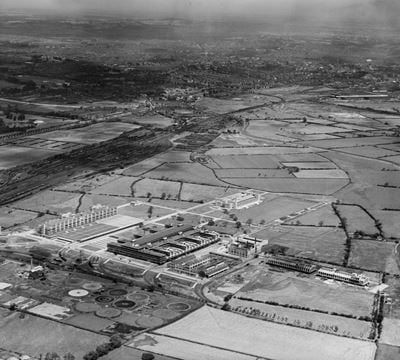
Nottingham
The Boots Pure Drug Co Works, Nottingham, 1939
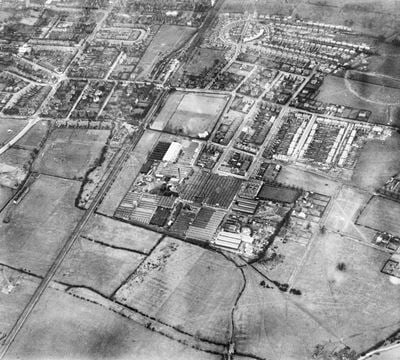
Beeston
The British Ericsson Telephone Works and environs, Beeston, 1937
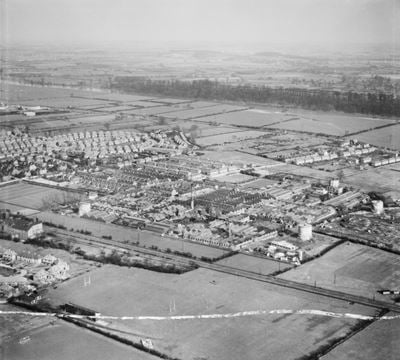
Beeston
The British Ericsson Telephone Works, Rylands Estate and environs, Beeston, 1947
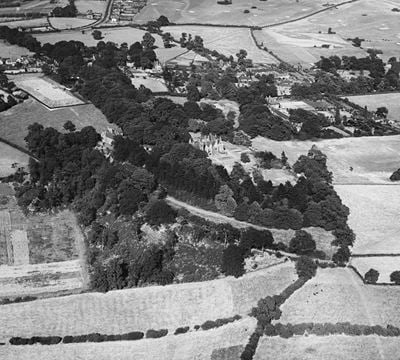
Bramcote
Bramcote Hall and environs, Bramcote, 1934

Bramcote
Bramcote Hall, Bramcote, 1934

Beeston
The Beeston Boiler Company Works, Beacon Road and environs, Beeston, 1934

Rylands
Padge Bridge and the residential area surrounding Lilac Crescent, Rylands, 1947

Stapleford
The Carr Fastener Co Works, Stapleford, 1951
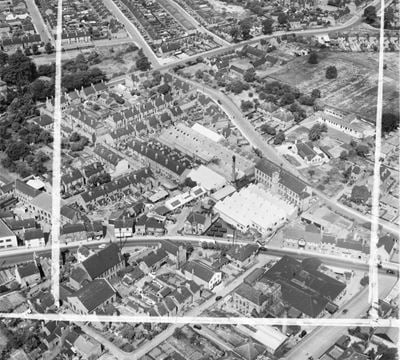
Stapleford
The Carr Fastener Co Works, Stapleford, 1951
Broxtowe in the Historic England Archive
The Historic England Archive cares for over 15 million images, dating from the 1850s to the present day. Discover stunning images of Broxtowe's past. Skip this section and go to stories about heritage
John Laing Collection
Broxtowe, Nottinghamshire
Date created: 17 Aug 1966
An interior view of a building under construction at the Trowell Service Area on the M1 Motorway near Nottingham
Nigel Temple Collection of Postcards of Parks and Gardens
Beeston, Broxtowe, Nottinghamshire
Date created: 1910 - 1920
GENERAL VIEW SHOWING PEOPLE ON THE RECREATION GROUND WITH BANDSTAND AND FACTORY CHIMNEYS IN THE DISTANCE
John Laing Collection
Broxtowe, Nottinghamshire
Date created: 17 Aug 1966
A view of the Trowell Service Area on the M1 Motorway during construction, showing the pedestrian footbridge over the carriageways
John Laing Collection
Beeston, Broxtowe, Nottinghamshire
Date created: May 1976
Machinery and equipment in a room in the tablet factory, known as Building D95, at the Boots factory site
John Laing Collection
Beeston, Broxtowe, Nottinghamshire
Date created: 01 Jul 1975
A man working at an electrical control tower in the suspended upper service floor of the tablet factory, known as Building D95, at the Boots factory
John Laing Collection
Beeston, Broxtowe, Nottinghamshire
Date created: 01 Jul 1975
An elevated view looking towards the tablet factory, known as Building D95, at the Boots factory, with the roof of Building D6 in the foreground
John Laing Collection
Beeston, Broxtowe, Nottinghamshire
Date created: May 1976
A view from the south-west of the tablet factory, known as Building D95, at the Boots factory site
John Laing Collection
Beeston, Broxtowe, Nottinghamshire
Date created: 01 Jul 1975
Two mechanical engineers installing an air conditioning unit in the tablet factory, known as Building D95, at the Boots factory
John Laing Collection
Beeston, Broxtowe, Nottinghamshire
Date created: 01 Jul 1975
An elevated view from the south showing the new tablet factory, known as Building D95, at the Boots factory site
John Laing Collection
Beeston, Broxtowe, Nottinghamshire
Date created: May 1976
A view of a large room with half-height partitions in which staff are working at equipment, in the tablet factory known as Building D95 at the Boots...
John Laing Collection
Beeston, Broxtowe, Nottinghamshire
Date created: May 1976
A view looking along a walkway on the service floor of the tablet factory, known as Building D95, at the Boots factory site
John Laing Collection
Beeston, Broxtowe, Nottinghamshire
Date created: May 1976
A view of a wide corridor showing a row of doors and interior windows in the tablet factory, known as Building D95, at the Boots factory site
Stories about heritage in your local area
Historic England publishes news, blogs, research, videos, and podcasts celebrating England's rich heritage. Discover the stories we have about Broxtowe. Skip this section and go to education
The Chilwell catastrophe: Fatal explosion on the home front
Mentions Memorial to workers of National Filling Factory No.6, Chilwell
One hundred years ago a catastrophic explosion tore through the National Shell Filling Factory at Chilwell, Nottinghamshire.
16 Remarkable Historic Places Listed in 2023
Mentions Swingate Water Tower
Take a closer look at the historic gems that were examined, protected and added to the National Heritage List for England in 2023.
Broxtowe's social history through photos
Over 10,000 images from the Historic England Archive have been specially selected and re-captioned for teachers, students, and anyone who wants to learn more about their local area. Skip this section and go to grant-aided places
Remains of Greasley Castle, Greasley, Nottinghamshire
Period: Medieval (Middle Ages) (1066 - 1484)
These farm buildings include the remains of a medieval castle. Greasley Castle was a fortified manor house. It was called a castle from 1340 onwards.
Remains of Greasley Castle, Greasley, Nottinghamshire
Lace and shawl warehouse, Wollaton Road, Beeston, Nottinghamshire
Period: Victorian (1837 - 1901)
This lace and shawl factory warehouse was built in 1892. It was built by J Huckerby for F Wilkinson.
Lace and shawl warehouse, Wollaton Road, Beeston, Nottinghamshire
Lace and shawl factory, Beeston, Nottinghamshire
Period: Victorian (1837 - 1901)
This building was part of a lace and shawl factory including the printing room, waiting room and gateway. It was built in stages from 1886-1893.
Lace and shawl factory, Beeston, Nottinghamshire
Hope Memorial, Beeston, Nottinghamshire
Period: Edwardian (1902 - 1913)
The war memorial was built in 1903. It is dedicated those who died in the Boer War in South Africa.
Hope Memorial, Beeston, Nottinghamshire
Tags
Durban House, Mansfield Road, Eastwood, Nottinghamshire
Period: Victorian (1837 - 1901)
Durban House was built in 1876 as offices for the Barber Walker Coal Co. It is now the Durban House Heritage Centre.
Durban House, Mansfield Road, Eastwood, Nottinghamshire
Derby Road, Beeston, Nottinghamshire
Period: 1950s (1950 - 1959)
A row of houses with upper storey workshops.
Derby Road, Beeston, Nottinghamshire
Boots Factory, Beeston, Nottinghamshire
Period: 1930s (1930 - 1938)
The pharmaceutical factory for the Boots Company was built in the 1930s and was designed by Sir E Owen Williams.
Boots Factory, Beeston, Nottinghamshire
Beauvale Priory, Greasley, Nottinghamshire
Period: Medieval (Middle Ages) (1066 - 1484)
The Carthusian Priory of Beauvale was founded by Nicholas de Cantilupo in 1343. It was for a prior and twelve monks.
Beauvale Priory, Greasley, Nottinghamshire
Tags
Discover more
Ready for more local stories? Take a look at these other places nearby
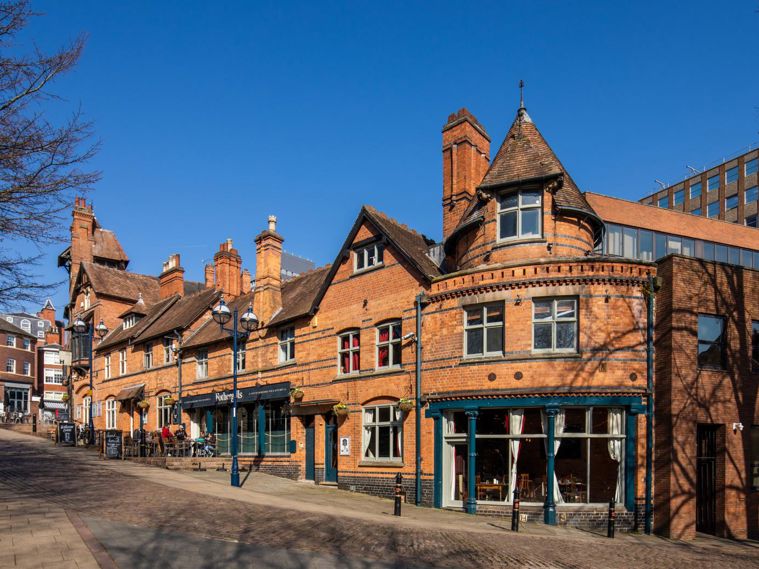
Nottingham
Local Authority District

Erewash
Local Authority District
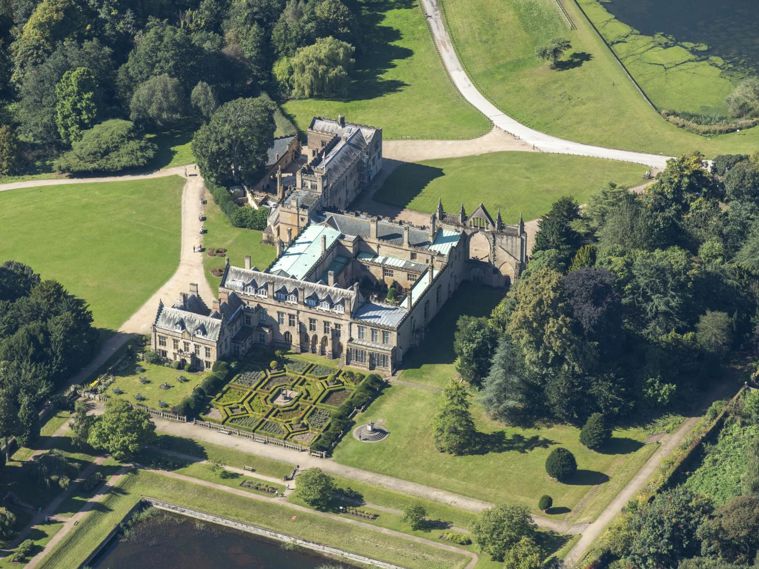
Ashfield
Local Authority District